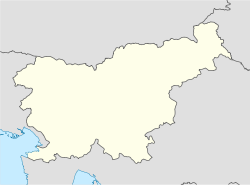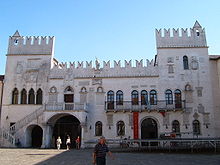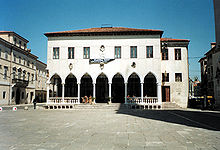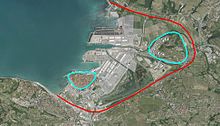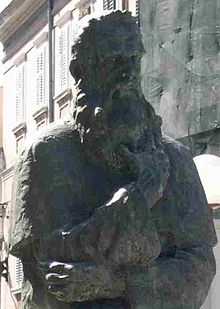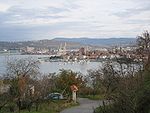- Koper
-
Koper
Capodistria— City and Municipality — 
Flag
Coat of armsLocation of the Municipality of Koper in Slovenia Location of the Town of Koper in Slovenia Coordinates: 45°33′N 13°44′E / 45.55°N 13.733°ECoordinates: 45°33′N 13°44′E / 45.55°N 13.733°E Country  Slovenia
SloveniaRegion Primorska Municipality Koper Government - Mayor Boris Popovič Area - Total 311.2 km2 (120.2 sq mi) Population (2002)[1] - Total 47,539 - Density 152.8/km2 (395.6/sq mi) Time zone CET (UTC+01) - Summer (DST) CEST (UTC+02) Source: Statistical Office of the Republic of Slovenia, census of 2002. Koper (
 pronunciation (help·info)) (Italian: Capodistria; Croatian: Kopar) is a coastal town and municipality and the largest commercial port in Slovenia, on the coast of the Adriatic Sea.[2] The town has a population of 23,726 and is the main urban center of Slovenian Istria.
pronunciation (help·info)) (Italian: Capodistria; Croatian: Kopar) is a coastal town and municipality and the largest commercial port in Slovenia, on the coast of the Adriatic Sea.[2] The town has a population of 23,726 and is the main urban center of Slovenian Istria.The town of Koper is officially bilingual, with both Slovene and Italian as official languages. Sights in Koper include the 15th-century Praetorian Palace and Loggia in Venetian Gothic style, the 12th century Carmine Rotunda church, and the Cathedral of St Nazarius, with its 14th-century tower.
Koper is also one of the main road entry points into Slovenia from Italy, which lies to the north of the municipality. The main motorway crossing is at Spodnje Škofije to the north of the town of Koper. The motorway continues into Rabuiese and Trieste. Koper also has a rail connection with the capital city, Ljubljana. On the coast, there is a crossing at Lazaret into Lazaretto in Muggia municipality in Trieste province. The Italian border crossing is known as San Bartolomeo.
Contents
History
Koper rose from an ancient settlement built on an island in the southeastern part of the Gulf of Koper in the northern Adriatic. In Ancient Greece, the town was known as Aegida. Later it became known by the Latin names of Capris, Caprea, Capre, or Caprista, from which the modern Slovenian name stems.In 568, Roman citizens of nearby Tergeste (modern Trieste) fled to Capris due to an invasion of the Lombards. In honour of the Byzantine emperor Justinian II, the town was renamed to Justinopolis. Later, Justinople was under both Lombard and Frankish rule and was shortly occupied by Avars in the 8th century.
Since the 8th century, possibly even since the 6th century, Koper was the seat of a diocese. One of Koper's bishops was the Lutheran reformer Pier Paolo Vergerio. In 1828, it was merged into the diocese of Trieste.
Trade between Koper and Venice has been recorded since 932. In the war between Venice and the Holy Roman Empire, Koper was on the German side, and was in result awarded with town rights, granted in 1035 by the emperor Conrad II. From 1232, Koper was under the Patriarch of Aquileia, and in 1278 it joined the Republic of Venice. It was at this time that the city walls and towers were partly demolished.[3]
In 1420, the Patriarch of Aquileia ceded his remaining possessions in Istria to the Republic, consolidating Venetian power in Koper.[4]
Koper grew to become the capital of Venetian Istria and was renamed Caput Histriae, "head of Istria" (from which stems its modern Italian name, Capodistria).
The sixteenth century saw the population of Koper fall drastically, from its high of between 10,000 and 12,000 inhabitants, due to repeated plague epidemics.[5] When Trieste became a free port in 1719, Koper lost its monopoly on trade, and its importance diminished further.[6]
According the census of the year 1900, 7205 Italian, 391 Slovenian, 167 Croatian, and 67 German inhabitants lived in Koper.
Assigned to Italy after World War I, at the end of World War II it was part of the Zone B of the Free Territory of Trieste, controlled by Yugoslavia. Most of the Italian inhabitants left the city by 1954, when the Free Territory of Trieste formally ceased to exist and Zone B became part of Socialist Federal Republic of Yugoslavia. In 1977, the Roman Catholic Diocese of Koper was separated from the Diocese of Trieste.
With Slovenian independence in 1991, Koper became the only commercial port in Slovenia. The University of Primorska is based in the town.
Population
The municipality has 47,539 inhabitants. Of these, 23,385 (49.19%) are male; 24,154 (50.81%) are female.
Italian was once the main language in the town, spoken by 92% of the population in 1900, but this number decreased sharply after Slovenian Istria was incorporated into Yugoslavia in 1954 and many ethnic Italians left the town. Today, Italian is mainly used as a second language by the Slovene-speaking majority.
- Population by native language, census 2002[7]
- Slovene 35,246 (74.14%)
- Croatian 3,824 (8.04%)
- Serbo-Croatian 1,911 (4.02%)
- Bosnian 1,311 (2.76%)
- Serbian 1,268 (2.67%)
- Italian 1,059 (2.23%)
- Albanian 240 (0.50%)
- Macedonian 227 (0.48%)
- Others and Unknown 2453 (5.16%)
- Total 47,539
The Port of Koper
Full article: Port of Koper
First established during the Roman Empire, the port of Koper has played an important role in the development of the area. It is among the largest in the region and is one of the most important transit routes for goods heading from Asia to central Europe. In contrast with other European ports, which are managed by port authorities, the activities of the Port of Koper comprise the management of the free zone area, the management of the port area and the role of terminal operator.
Prominent citizens
- Zvest Apollonio (1935–2009), painter
- Gian Rinaldo Carli (1720–1795), man of letters
- Vittore Carpaccio (c. 1460 – c. 1525), painter. Born in Venice, lived in Koper (then Capodistria)
- Boris Cavazza (1939 – ), actor
- Aldo Cherini (1919 – ), historian and writer[8]
- Giorgio Cobolli, Italian gold medal in the Second World War[9]
- Lucija Čok, linguist, politician
- Zlatko Dedič (1984 – ), football player
- Lorella Flego (1974 – ), TV entertainer
- Rudolf Golouh (1887–1982), politician and author
- Aurelio Juri (1949 – ), politician
- Franco Juri (1956 – ), politician, musician
- Ioannis Kapodistrias (1776–1831), Greek patriot and first governor of the Greek state (1828–1831) his family hailed originally from Koper/Capodistria
- Andreja Klepač (1986 – ), professional tennis player
- Tinkara Kovač (1978 – ), singer
- Bruno Maier (1922–2001), writer and literary critic[10]
- Matjaž Markič (1983 – ), swimmer
- Davor Mizerit (1981 – ), rower
- Igor Pribac (1958 – ), philosopher
- Pier Antonio Quarantotti Gambini (1910–1965), journalist and writer. Born in Pazin (then Pisino), lived in Koper (then Capodistria)[11][12]
- Tomaž Šalamun (1941 – ), poet
- Santorio Santorio (1561–1636), medical scientist
- Nazario Sauro (1880–1916), Italian irredentist and sailor
- Spartaco Schergat (1920–1996), military frogman, sank the English battleship Queen Elizabeth in 1941. Italian gold medal in the Second World War[13]
- Francesco Trevisani (1656–1746), painter
- Pier Paolo Vergerio the Elder (1370 – 1444/1445), humanist, statesman and canonist[14]
- Pier Paolo Vergerio the Young (1498–1565), man of Church
- Captain Antonio Zetto, traveller, Globe Trotting: A Ten Years Walk 1922 – 1932
- Vittorio Italico Zupelli (1859–1945), general, minister
- Boštjan Žvanut (1975–), former Rolling Stones
International relations
See also: List of twin towns and sister cities in SloveniaTwin towns – Sister cities
Koper is twinned with:
References
Notes
- ^ Statistical Office of the Republic of Slovenia, census of 2002. Stat.si. Retrieved on 24 September 2011.
- ^ Entry for Koper in the Lonely Planet Guide to Slovenia. Books.google.com (15 May 2007). Retrieved on 24 September 2011.
- ^ "A Historical Outline Of Istria". Zrs-kp.si. http://www.zrs-kp.si/zrs/zgodovina/e-middle.html. Retrieved 27 March 2010.
- ^ Schutte, Anne Jacobson: Pier Paolo Vergerio: the making of an Italian reformer; p23. Books.google.com. Retrieved on 24 September 2011.
- ^ Schutte, Anne Jacobson; p24. Books.google.com. Retrieved on 24 September 2011.
- ^ "History of Koper – Lonely Planet Travel Information". Lonelyplanet.com. http://www.lonelyplanet.com/slovenia/karst-and-coast/koper/history. Retrieved 27 March 2010.
- ^ Slovenian Statistics Office site, results of the 2002 census. Stat.si. Retrieved on 24 September 2011.
- ^ Page in Italian about Aldo Cherini. Istrianet.org. Retrieved on 24 September 2011.
- ^ Brief article in Italian from ''Corriere della Sera'': ''Lutto, muore Giorgio Cobolli eroe della Guerra d'Africa'' (George Cobolli, hero of African War, is dead). Archiviostorico.corriere.it (24 December 2009). Retrieved on 24 September 2011.
- ^ Page on Bruno Maier in Italian. Istrianet.org. Retrieved on 24 September 2011.
- ^ [1][dead link]
- ^ 'http://www.retecivica.trieste.it/ipe_archivio/agm/ts.pdf
- ^ Article in Italian about the sinking of the battleship Queen Elizabeth.
- ^ Press on ''Vergerius, Petrus Paulus''. Istrianet.org. Retrieved on 24 September 2011.
- ^ "AllCorfu.Com: Corfu's Twin Cities". allcorfu.com. http://www.allcorfu.com/in-trivia.html. Retrieved 25 February 2010.
- ^ a b "Comune di Ferrara – Portale Telematico Estense". Ferrara.comune.fe.it. http://ferrara.comune.fe.it/. Retrieved 27 March 2010.
- ^ "Sito ufficiale del Comune di Muggia". Comune.muggia.ts.it. http://www.comune.muggia.ts.it/. Retrieved 27 March 2010.
- ^ "Sito Web del Comune di S.Dorligo della Valle – Dolina (TS)". Comune.san-dorligo-della-valle.ts.it. http://www.comune.san-dorligo-della-valle.ts.it/. Retrieved 27 March 2010.
- ^ [2][dead link]
- ^ "Welcome to JiuJiang". Jiujiang.gov.cn. http://www.jiujiang.gov.cn/English/. Retrieved 25 February 2010.
- ^ http://72.30.186.56/search/cache?ei=UTF-8&p=Saint+John%27s+sister+cities&type=yahoo_avg_hs2-tb-web_chrome_us&fr=yhs-avg-chrome&u=clevelandslovenian.com/&w=saint+john%27s+john+sister+cities&d=dDjhxhlMTA7T&icp=1&.intl=us
External links
- Official website in English
- Port of Koper (in Slovene)
- University of Primorska (in Slovene)
- Aerial view of Koper
- Students' Association of Koper (KŠOK)
- Panoramas of Koper and surrounding area
- Old pictures of Koper/Capodistria
Municipalities of Slovenia Urban Celje · Koper · Kranj · Ljubljana · Maribor · Murska Sobota · Nova Gorica · Novo Mesto · Ptuj · Slovenj Gradec · VelenjeNon-urban Ajdovščina · Apače · Beltinci · Benedikt · Bistrica ob Sotli · Bled · Bloke · Bohinj · Borovnica · Bovec · Braslovče · Brda · Brežice · Brezovica · Cankova · Cerklje na Gorenjskem · Cerknica · Cerkno · Cerkvenjak · Cirkulane · Črenšovci · Črna na Koroškem · Črnomelj · Destrnik · Divača · Dobje · Dobrepolje · Dobrna · Dobrova-Polhov Gradec · Dobrovnik · Dol pri Ljubljani · Dolenjske Toplice · Domžale · Dornava · Dravograd · Duplek · Gorenja vas-Poljane · Gorišnica · Gorje · Gornja Radgona · Gornji Grad · Gornji Petrovci · Grad · Grosuplje · Hajdina · Hoče-Slivnica · Hodoš · Horjul · Hrastnik · Hrpelje-Kozina · Idrija · Ig · Ilirska Bistrica · Ivančna Gorica · Izola · Jesenice · Jezersko · Juršinci · Kamnik · Kanal ob Soči · Kidričevo · Kobarid · Kobilje · Kočevje · Komen · Komenda · Kostanjevica na Krki · Kostel · Kozje · Kranjska Gora · Križevci · Krško · Kungota · Kuzma · Laško · Lenart · Lendava · Litija · Ljubno · Ljutomer · Log-Dragomer · Logatec · Loška dolina · Loški Potok · Lovrenc na Pohorju · Luče · Lukovica · Majšperk · Makole · Markovci · Medvode · Mengeš · Metlika · Mežica · Miklavž na Dravskem polju · Miren-Kostanjevica · Mirna · Mirna Peč · Mislinja · Mokronog-Trebelno · Moravče · Moravske Toplice · Mozirje · Muta · Naklo · Nazarje · Odranci · Oplotnica · Ormož · Osilnica · Pesnica · Piran · Pivka · Podčetrtek · Podlehnik · Podvelka · Poljčane · Polzela · Postojna · Prebold · Preddvor · Prevalje · Puconci · Rače-Fram · Radeče · Radenci · Radlje ob Dravi · Radovljica · Ravne na Koroškem · Razkrižje · Rečica ob Savinji · Renče-Vogrsko · Ribnica · Ribnica na Pohorju · Rogaška Slatina · Rogašovci · Rogatec · Ruše · Šalovci · Selnica ob Dravi · Semič · Šempeter-Vrtojba · Šenčur · Šentilj · Šentjernej · Šentjur · Šentrupert · Sevnica · Sežana · Škocjan · Škofja Loka · Škofljica · Slovenska Bistrica · Slovenske Konjice · Šmarje pri Jelšah · Šmarješke Toplice · Šmartno pri Litiji · Šmartno ob Paki · Sodražica · Solčava · Šoštanj · Središče ob Dravi · Starše · Štore · Straža · Sveta Ana · Sveta Trojica v Slovenskih goricah · Sveti Andraž v Slovenskih goricah · Sveti Jurij ob Ščavnici · Sveti Jurij v Slovenskih goricah · Sveti Tomaž · Tabor · Tišina · Tolmin · Trbovlje · Trebnje · Trnovska vas · Tržič · Trzin · Turnišče · Velika Polana · Velike Lašče · Veržej · Videm · Vipava · Vitanje · Vodice · Vojnik · Vransko · Vrhnika · Vuzenica · Zagorje ob Savi · Žalec · Zavrč · Železniki · Žetale · Žiri · Žirovnica · Zreče · ŽužemberkTowns, villages and landforms of the Slovenian Riviera  Categories:
Categories:- Koper
- Municipalities of Slovenia
- Port cities and towns of the Adriatic Sea
- Populated places in the Municipality of Koper
- Italy–Slovenia border crossings
- Slovenian Riviera
- Port cities in Slovenia
- Populated coastal places in Slovenia
Wikimedia Foundation. 2010.



